The theme of the workshop sessions held during the HNC group’s February Weekend was Block Threading. I’ve already discussed this in some detail in an earlier blog. I now found myself in the workshop on a Thursday poised to come to grips with block threading on my own. During the workshop sessions most of the group attempted to weave three different swatches on five available dobby looms: it certainly wasn’t the atmosphere to slowly work out how the threading and the dobby pegging (read treadling on a floor loom, shaft-lifting on a table-loom) interacted. I could sense this was no problem at all for most of the class, but for me I found, even with the computer visualization on WeaveIt, not all my questions were answered.
I devoted the whole of my weekly workshop session to painstakingly answering all my questions, and towards the end of the day weaving two swatches. I decided I would use the Louet Dobby loom. This is a small footprint 16-shaft loom with a dobby mechanism that has a revolving tray of fixed lags into which you place hard plastic pegs. None of this removing the lags and hammering in pegs on this dobby loom to set up your patterns. This Louet loom is similar in design to 24-shaft ‘magic’ Louet which interfaces with a computer, the dobby ‘pegging’ handled in the software. Both Louets can be stepped forward or backward and the lifting pattern engaged by means of a pedal or on the non-computer loom a stout handle.
I began my exploration of the Louet by focusing on the dobby lags already filled with a peg pattern. We had been supplied with the draft notation showing both a threading plan and the weave notation. First hurdle: remember to read the draft from top to bottom. Threading (first) is directly above the weave notation (second) – and none of this front to back American nonsense. In Marianne Straub’s wonderful book Handweaving and Cloth Design she shows exactly how a Dobby-loom lifting plan works. She even includes (for beginners) an additional notation for the position of the pegs on each lag. I only ‘wish’ I’d had the foresight to bring the book with me to the February weekend. I continue to find so much is assumed in the course notes provided and rarely any referencing to what these diagrams mean, and as there are many different approaches to draft notation it’s easy for people as stupid as me to get confused.
So I struggled for quite some time to understand the way the pegs in the lags lined up with the draft I’d been provided with. Eventually I got there! Next stage was to understand how the threading matched up with the lifting plan. It was at this point I reckoned a little bit of experimental weaving wouldn’t go amiss. So I chose a yarn that clashed purposely and horrendously with the soft green and lime and an undyed linen warp and started to see what happened when I wove according to the lifting plan. Hmm . . . lots more questions now, mainly to do with the selvedge sections of the warp.
On the workshop days I heard fellow students talk with authority about ‘catching the selvedge’ and ‘locked selvedges’. I did ask one or two people what this meant but found their explanations confused! So I cornered Graham the workshop technical expert in a spare moment, and he kindly and patiently explained all, including taking me through the threading of the selvedge portions of the warp I was working with. I now understood why I’d had such a hard time during my brief spell on one of the George Wood looms when I’d seemed to need to ‘catch’ the selvedge most of the time. I learned later that the warp I’d been weaving on hadn’t got a ‘locked’ selvedge to help me out. Essentially, this means that by sensible threading (which seemed to be in everybody’s warping vocabulary except mine) you can make sure you ‘catch’ the selvedge every time – depending on the complexity of your draft of course.
Let’s take a look at the warp I’m going to weave on, and attempt a description. The warp is made up of three-colour blocks threaded across 12 shafts with a selvedge on 13-16: the first sequence is of undyed linen (10 + 12), a lime 4 8s cotton (12) and a green cotton/linen mix (12), the second (12 -12 -12 ), the third (12 – 12 -12 ) with a final 10 of undyed linen. The e.p.i is 14, width 8″ with 128 ends.
My first weave attempt using the horrendous clashing red / orange linen worked through the given lifting plan and then reversed it. It took me a while to realise why each block pattern was separated by an empty lag, but I can see the great sense in this if you want to play with the pattern sequence. Anyway, it all seemed pretty straightforward, but I did want to produced something which looked reasonable. Finding a colour to match the greens that also made the most of the changes of pattern across the blocks wasn’t easy until I stumbled upon a lively multi-coloured yarn, something I would normally steer away from. But I think the results speak for themselves. I wove a whole pattern twice and then doubled the weft throw giving me a thicker quality to the effect and requiring just one pass through the lifting sequence. It was getting pretty late when I finished this, and that’s my excuse for some rather compressed selvedges on the double pass weft section of my woven piece. Say twenty times: ‘I must remember that making a double shoot requires a lighter touch laying the weft on the warp and beating it too’.
Last week I didn’t make it into college, the first Thursday I’ve missed since I started. I was due to work on the George Wood dobby-looms and my tutor felt that as the technician was away that day I perhaps couldn’t handle it. Probably wise, and, as ever seemingly, I have been struggling to finish the editing of a new score (a wind octet for a Canadian summer festival) so I was quite glad of an unexpected day at my studio. But this week I’ll be back, hopefully with some ideas about the next project, that is if it is unnecessary for me to resubmit the last project, which is still to be assessed. My eldest daughter (a geographer) gave me a great starting point which I’m playing with – the aerial photographs of Yann Arthus-Bertrand, images that both conceal and reveal (one of the titles of Project 3).
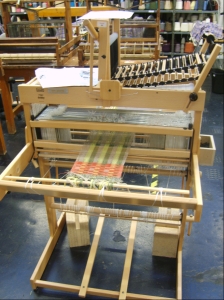
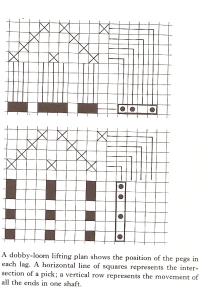
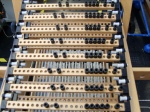
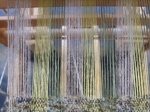
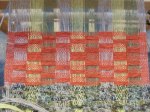
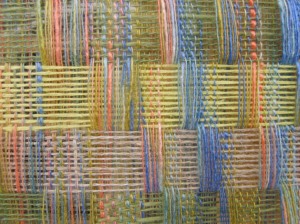
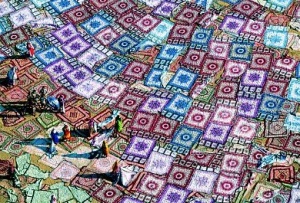
March 10, 2009 at 10:55 pm |
I’m beginning to think that a great reason for doing a course like this is all the different looms you get to try out!
Re. understanding different looms, when I started weaving on my table loom I was quite puzzled for a bit as to how to get the right shafts lifted. I hadn’t realised how much I take for granted about the loom I’m familiar with. With a table loom I realised the shaft lifts are like a dobby – every time you change shed you need to operate the lever for the shafts you need. I know it seems simple to read this – but my brain didn’t get it until I’d made a few false starts!!
That photo of Yann Arthus-Bertrand’s is amazing.
March 11, 2009 at 12:30 am |
I for one think you are doing marvelously well. In the United States. I have never heard the phrase “catch the selvedges” but it certainly says what it means. In my current weaving I should have threaded selvedges on shafts 5 and 6. I had thought using a floating selvedge (a selvedge warp you thread through the reed but not through the heddle, then you weave over the first warp and under the last) which normally works quite well. But because this is a block weave, it didn’t work, so the selvedges are messy. This is something I have just figured out on my own—you are lucky to have a technician on call!
I agree with Dot about the photos. I explored the site just a bit and found the pet/owner photos. Priceless!
March 11, 2009 at 7:40 am |
I have just been alerted to this blog by Margreet Ward. As a graduate of 2004, doing the course in blocks, I often wish Graham was within easy reach!
I am now going to look at the rest of the site whilst I recover from a fabulous weekend in The Hague with lots of fantastic Dutch spinners.